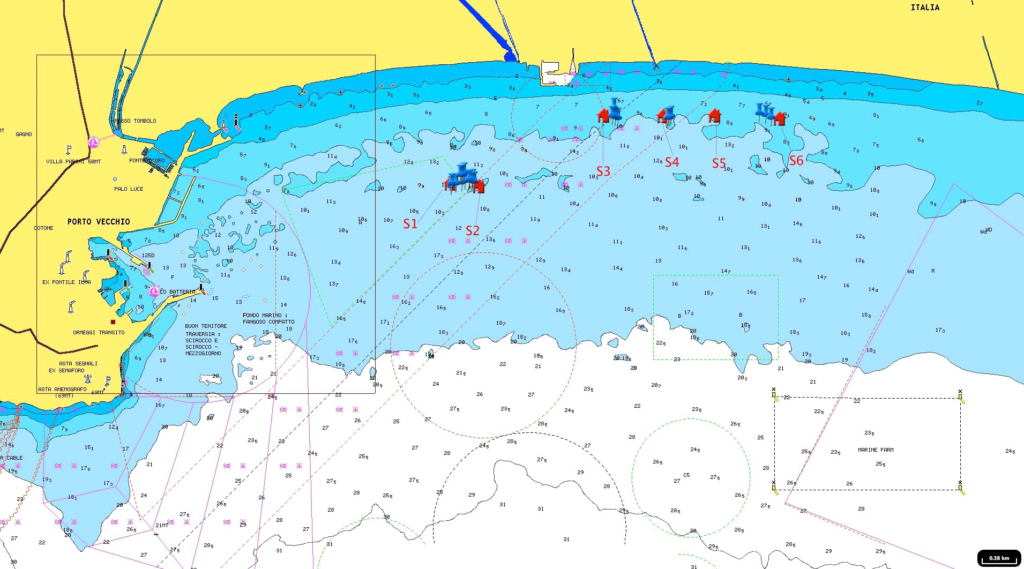Piombino
Context
The removal of a portion of the Posidonia oceanica prairie, formerly present in the area of the Port of Piombino ( Northern Tyrrhenian Sea), was carried out as part of the maritime works foreseen by the new Port Regulatory Plan of the Port of Piombino (LI), a polluted area designated as Site of National Interest (SIN). Then, a transplant of P. oceanica was prescribed to the former Port Authority of Piombino as a measure of compensation for the damage done to the prairie in the decree of Environmental Impact Assessment (VIA 478/2012), issued by the Ministry of the Environment and the Protection of the Territory and the Sea (MATTM) .
The transplant was carried out in June 2014 in areas identified as suitable in the Gulf of Follonica, in the Perelli locality (Fig. 1).
Transplant technique
The transplantation technique used involved the transfer of clods of P. oceanica with a surface area of 4 m2 (Fig.2a), removed from the seabed with a hydraulic clamshell bucket (Fig.2b), which allows the removal of clods avoiding fragmentation and permits their subsequent positioning. Furthermore, the motor ship used splite barge (Fig. 2c), with the possibility of introducing water in the clod containment area (Fig. 2d) and thus keeping alive all marine organisms that live among rhizomes, leaves, matte of P. oceanica until they are re-positioned on the bottom. The clods were placed in the center of the hull one at a time and then placed on the bottom.
For positioning at sea bottom, scuba divers indicated, with floating buoys, the exact point where to sink the clod (Fig. 2e) on which a numbered identification buoy was implanted on a stake (Fig. 2f). Geographic coordinates were taken of the areas where the clods were positioned were taken.

a: Hydraulic clamshell bucket; b: clod of P. oceanica (2×2 m); c: motor ship splite
barge; d: P. oceanica immersed in sea water inside the hull of the motor ship; e:
The buoys indicate where the bucket must accompany the sod to the bottom; f:
example of numbered buoy
Former monitoring in 2014
After the end of the transplant operations, four monitoring surveys were carried out over the next 3 years, up to June 2017. The monitoring included the photographic video inspection of most of the clods (n = 314) in the placement areas. The placement areas were extended from about 100 to 400 meters. In Fig. 3 the temporal phases of transplantation and subsequent monitoring are schematically represented.

Figure 3 – Timeline of the monitoring campaigns carried out on the Piombino site from the time of transplantation
Monitoring activities in the context of LIFE SEPOSSO project
Between 9-10 October 2018 the SEPOSSO Partnership participated in the field activities on the transplant site of Piombino. A total of 11 divers from the AdSPMTS, University of Palermo, University of Rome “Tor Vergata”, ISPRA, ARPAT participated in the activities. As part of these activities, a pre-dive briefing was carried out, where the AdSPMTS, based on the experience gained in the previous stages of transplantation and monitoring
on the site, it coordinated the activities with the support of the entire Partnership.
In total, all the transplanted stations (S1-S2, S3, S4-S5, S6) and relative control stations for each station were monitored. Different surveys were carried out in the stations under study according to a new monitoring protocol discussed and shared by the entire LIFE SEPOSSO Consortium.
16 plates were randomly selected in each station. The total number of clods selected, equal to 62, represents about 20% of all clods transferred. The clods have been identified among those positioned near the upper limit of the prairie on a sandy bottom, some of which are adjacent to it.
The following activities were carried out in each clod:
- Measurement of the N-S diagonal (cm) and E-W diagonal (cm)
- Leaf density count
- Length and width of the longest leaf, state of the apex and brown tissue (5 bundles)
- 1 photograph perpendicular to the sediment from above the sod
- 4 side photographs
Additional notes for each clod to support photographic monitoring:
– Posidonia coverage in the clod (%)
– Apparent clod retention (high, medium, low)
– Natural grassland distance from the sod (near, far)
– Distance other clods from the clod (adjacent, near, far)
– Presence of plagiotropic beams (high, medium, low) for each lateral photograph
Footage acquired on the station S3 in 2018


